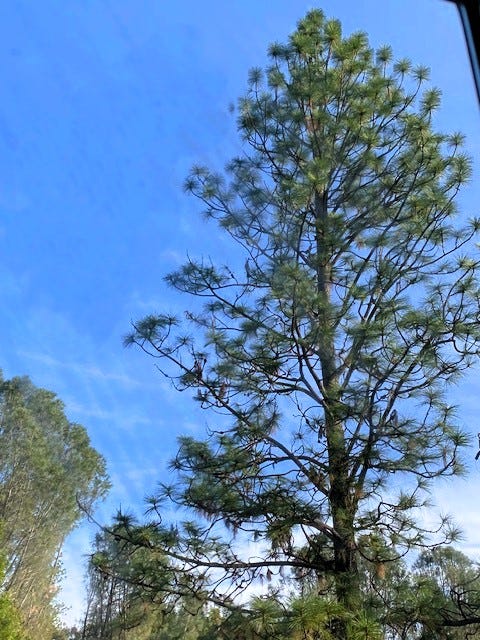What the trees are telling us
With drought, climate change, and disease, it’s been a hard time for trees these last few years. I live in the Sierra foothills, where you’re never far from a majestic tree, or a few thousand of them, so it hits hard when I see signs of distress out there.
For instance, it’s breaking my heart to see the Coulter pine that lives in front of our house (photo) hopelessly infected with fungal galls. I know so little about trees (even if I appreciate them) that I never inspected this one closely. It was only when it shed thousands of needles this fall that I called in an arborist, who identified the galls at first sight. He said there was a very expensive treatment I could try, but the galls are all over the thing now and can’t be pruned out.
We lost a nice blue spruce earlier this year, and every winter several digger pines fall down in high winds around here, along with oaks that happen to stand in less firm soil.
One of our cedars’ tops went bare I don’t know when. I looked up one day and noticed, but the arborist says a new top will form next to it eventually. Another Coulter beside the cedar has a few sap knobs, and the arborist says a single beetle is responsible for each. It’s possible to knock away all the sap, which is the tree’s defense mechanism to drown the beetles, then go in there and dig out the intruder, but it’s probably not worth it. Until the tree is infested, this is part of its life.
On our hikes in the region we see a lot of dead trees. They’ve succumbed to beetle infestations, blights, drought, and dozens of other maladies. At one spot that was fully green when we moved here almost nine years ago, the hillsides are streaked with acres of dead pines. Then there’s the fire damage all around the foothills. We’ve been putting off a drive that will take us through the gigantic scar left behind by last year’s Mosquito fire, but there’s a grove of sequoias out there that was saved. We feel like we’d better pay a visit before they too run into trouble.
I’ve come to think of the trees as harbingers, like the canary in the coal mine. They’re talking to us. They’re telling us things are bad. Last winter it rained so much that the drought-stressed oaks in one of our favorite hiking areas tried to drink up all the water they could and their roots rotted, causing them to fall in the next big storm. We walked around in awe at the carnage, hundreds of trees cleaved right under the bases of their trunks. A ranger warned us to keep our heads up as we walked because a lot of the standing trees could come down any minute.
Aside from a black oak death pandemic back in the ‘90s, I can’t recall a mass tree die-off in my time. I suppose I took them for granted, like they were sturdy buildings, infrastructure. The oldest beings on the planet are trees, so we were lulled into a sense of permanence about them. Now I’m not so sure. I imagine outliving all the trees on our property and looking out at a depressing barescape just as I’m getting ready to leave the earth.
The only thing to do is keep planting. I put in a new blue spruce recently. Changing things up, I’ll probably let a few volunteer oak saplings grow these next few years, where my habit has always been to take them out. I’m watching that sick Coulter pine, which I can see from my home-office window, but I know there’s no way to replace it with anything that will come close to its quality. It’s going to leave quite a hole in the sky.



It must be hard to see the effect of climate change on trees where you live. Where I am, developers are their greatest threat.
One of our favorite hiking spots when we lived in CA was Big Basin State Park (Santa Cruz). Greg had been hiking there since the late 70s so he was well familiar with the trees. A couple of years ago a fire went through the park, presumably destroying a lot of them. Perhaps, once we're all gone, trees can thrive again.